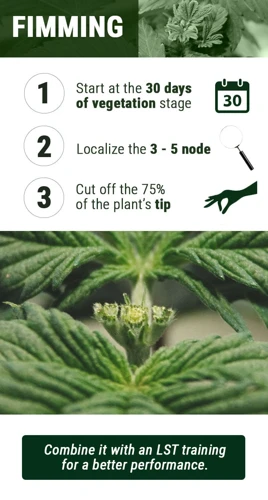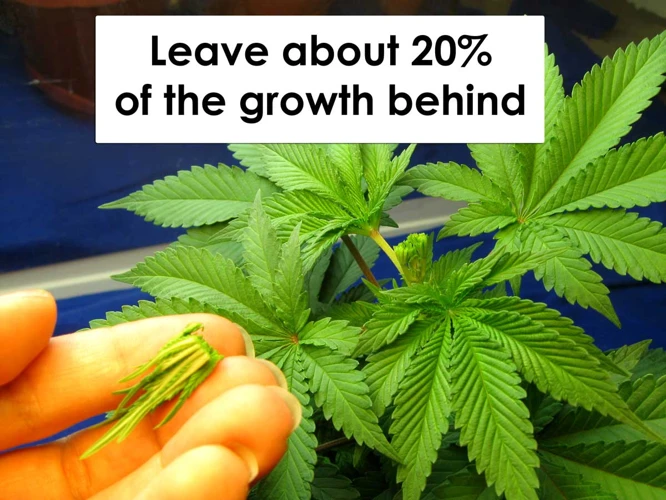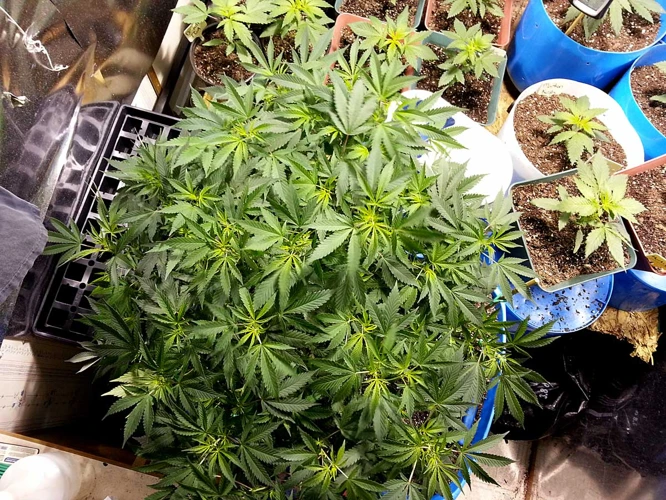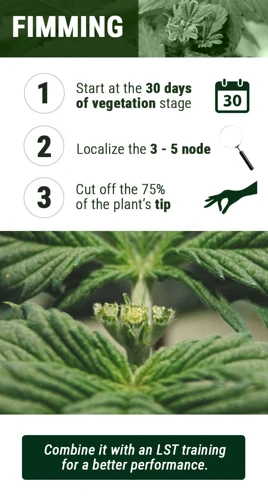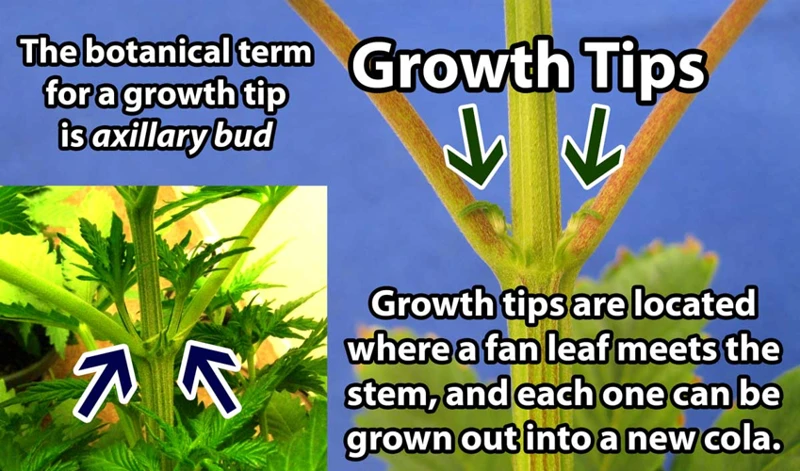
Fimming Cannabis Plants: Optimal Growth Techniques
Every cannabis grower knows that the key to achieving impressive yields and potent buds lies in proper plant training techniques. One of those techniques is known as fimming. But what is fimming, and is it really beneficial for your cannabis plants? Fimming is a form of pruning that involves the removal of the latest growth tips of your cannabis plant. This technique forces your plant to grow bushier and create more colas, ultimately leading to higher yields. However, fimming is not without its risks, and it may not be suitable for all types of cannabis plants. In this detailed guide, we will explore what fimming is, how to do it, when to do it, and the many benefits and risks associated with this training technique.
What is Fimming?
Contents
Fimming, also known as “pinching,” is a cannabis plant training technique that involves removing a portion of the growth tip of the plant’s stem just above the newest set of leaves. This process encourages the plant to grow more side branches, resulting in a bushier plant with multiple colas (large, dense clusters of buds).
Fimming is essentially a type of pruning that focuses on slowing vertical growth and redirecting the plant’s energy to lateral growth. By removing the top growth, the plant will develop new nodes at the base of the remaining stem, and each of these new nodes will develop into two new branches. This result in a bushier plant that is more efficient at utilizing the available light.
Fimming is often compared to another popular cannabis plant training technique known as topping. While both techniques involve removing the top of the plant’s stem, topping typically involves removing the entire top of the plant, including the newest growth tips. Topping typically results in two main colas, whereas Fimming results in more colas but smaller in sizes.
The main difference between these two methods is that topping is more aggressive, and it requires slightly more precision compared to Fimming. With Fimming, the risk of over-pruning and stunting the plant’s growth is lower, and the plant tends to recover quickly from the process.
Fimming is a gentler and more beginner-friendly plant training technique that can still produce impressive results in terms of yield and plant structure.
The Basics of Fimming
If you’re new to growing cannabis, you might wonder what fimming is all about. Fimming is a pruning technique that can help your cannabis plants grow bushier and produce more buds. Fimming involves removing part of the plant’s new growth to stimulate the growth of lateral branches. This creates more bud sites, which can ultimately lead to a bigger harvest. In this section, we will delve into the basics of fimming and explain how it can benefit your cannabis plants.
Fimming vs Topping
When it comes to maximizing the growth and yield of your cannabis plants, fimming and topping are two techniques that can be highly effective. Although both options yield similar results, there are some distinct differences between the two methods.
The Basics of Topping:
Topping is the process of cutting off the top of the main stem to encourage the growth of two new branches. This technique is usually performed during the vegetative stage of growth, when the plant has at least four to six sets of true leaves.
The Basics of Fimming:
Fimming, on the other hand, is similar to topping but involves cutting off just the topmost part of the plant. This results in the growth of four new branches instead of two, and is also performed during the vegetative stage of growth.
Fimming vs Topping:
Here are some of the key differences between fimming and topping:
- Number of Branches: Fimming produces four new branches, while topping produces two.
- Recovery Time: Fimming is less stressful for the plant and typically results in a quicker recovery time compared to topping.
- Yield: Because fimming results in the growth of more branches, it has the potential to produce a higher yield than topping.
It’s important to note that both fimming and topping can be stressful for plants, and therefore should be done with care. Additionally, the amount of growth and yield increases can vary depending on the strain of cannabis being grown. Ultimately, the decision to use either fimming or topping will depend on personal preference and the specific needs of the plants.
When to Fim Your Cannabis Plants
Knowing when to fim your cannabis plants is crucial for optimal growth and increased yields. When you choose to fim your plants will largely depend on the stage of growth they are in.
The Vegetative Stage
The vegetative stage is the ideal time to begin fimming your cannabis plants. This stage typically lasts between 3-4 weeks and is characterized by rapid growth and the development of a strong root system. During this stage, your plants are able to handle the stress caused by fimming and will respond positively to the increased branching that occurs.
The Flowering Stage
While fimming can be done during the flowering stage, it is generally not recommended. This is because the flowering stage is when your plants are devoting all of their energy towards producing buds. Fimming during this stage can cause stress to your plants and result in decreased yields.
Ultimately, when you decide to fim your cannabis plants will depend on your specific goals for your grow. It is important to note that fimming should only be done once your plants have developed enough nodes to ensure that the cuttings will result in the development of healthy branches. Additionally, you should take care not to fim your plants too late in the vegetative stage as this can also cause stress and slow down growth.
Vegetative Stage
During the vegetative stage, your cannabis plants are developing their leaves, stems, and branches. This stage is crucial for your plants to grow strong and healthy, as it lays the foundation for a successful harvest. At this stage, your plants are not yet producing buds, but rather focusing on building a sturdy structure. It’s important to give your plants the right amount of light, water, and nutrients during the vegetative stage to ensure they grow to their fullest potential. Let’s explore when and how to fim your cannabis plants during this important stage.
Flowering Stage
During the flowering stage, fimming your cannabis plants should be done with caution. This is because the plant is already using most of its energy to develop buds, and any further stress could result in less than ideal yields. However, if done correctly, fimming during flowering can still result in a larger yield.
Here are some factors to consider before fimming during the flowering stage:
- Plant Health: Your cannabis plant should be healthy before attempting to fim during the flowering stage. Any previous stress or damage could have negative effects on bud development.
- Plant Height: Fimming during the flowering stage may not be recommended for taller plants as they may not have enough time to recover before the end of the flowering cycle.
- Timing: Fimming during the early stages of the flowering cycle is recommended. This is because the plant will have enough time to recover and produce more buds by the end of the cycle.
If you decide to fim during the flowering stage, it’s recommended to only do it once. This is because fimming multiple times during this stage could cause too much stress on the plant and result in slower growth and lower yields.
It’s important to note that fimming during the flowering stage is not recommended for beginners. It requires experience and knowledge to properly execute and avoid potential problems.
How to Fim Your Cannabis Plants
When it comes to fimming your cannabis plants, it’s important to have the right supplies and follow the proper process to minimize the risk of plant damage and ensure the best possible results. Here’s how to do it:
The Supplies You’ll Need:
To fim your cannabis plants, you’ll need a few key supplies:
1. Sharp scissors – Make sure your scissors are clean and sterile to prevent the spread of disease or infection.
2. Rubbing alcohol – Use rubbing alcohol to sterilize your scissors before and after each cut.
3. Gloves – Wear disposable gloves to prevent contaminating your plants with any bacteria or fungi from your hands.
The Fimming Process:
1. Identify the node – Look for the topmost node on the stem of your cannabis plant, which will have new branches and leaves growing out of it. This is where you want to make your cut.
2. Cut off the top of the node – Use your sharp scissors to carefully snip off the very top of the node, at an angle. Make sure to cut just above the new growth, as this will encourage the plant to branch out more.
3. Wait for new growth – After a week or so, you should start to see new growth branching out from where you made the cut. This is a good sign that your plant is responding well to the fimming and should result in more colas and bigger buds.
Important Tips:
– Be gentle when making your cut, as too much force or jagged edges can damage the plant.
– Only fim your plant once per node to avoid stunting its growth.
– Do not fim your plant during its flowering stage, as it can cause stress and reduce the quality of the buds.
– If you notice any signs of infection or disease, stop fimming immediately and consult with a professional.
By following these instructions and taking proper precautions, you can fim your cannabis plants safely and effectively, resulting in a healthier, higher-yield harvest.
The Supplies You’ll Need
Before attempting to fim your cannabis plants, it’s essential to gather all the necessary supplies. Being well prepared will ensure a smooth and successful fimming process. You’ll need several essential tools, including sharp scissors or pruning shears and rubbing alcohol. It’s crucial to keep everything as clean as possible to avoid any potential damage or infection to your plants. Make sure your scissors are sharp and sanitized with rubbing alcohol before trimming any part of your cannabis plant. Additionally, prepare a clean work area and wear gloves if you prefer to avoid contact with the plant’s resin. By having all the supplies on hand, you’ll be prepared to fim your cannabis plants efficiently and safely.
The Fimming Process
To begin the fimming process, you will need a pair of clean, sharp scissors or pruning shears. It is important that the blades are clean to prevent any potential infection or disease from spreading through the plant.
Here are the steps to follow for fimming your cannabis plants:
- Identify the stem that you want to fim. Fimming typically involves targeting the newest growth on a plant, which is located at the very top of the stem.
- Locate the growth tip at the top of the stem. You should see one main growth tip and several smaller leaves growing out from the node.
- Using your scissors or pruning shears, make a clean, diagonal cut about 80% of the way through the stem directly above the new growth. Be sure to avoid cutting too close to the plant’s main stem, as this could cause unnecessary stress to the plant.
- The goal of fimming is to cut the growth tip and remove the majority of it, while leaving the smaller growth shoots intact.
- After the cut has been made, discard the growth tip and any stray leaves that were removed along with it.
- Wait a few days and monitor your plant’s growth. You should begin to see new growth shoots emerge from the site of the cut.
It is important to note that while fimming is a relatively simple process, it can have a significant impact on the growth of your plants. Be sure to follow the steps carefully, and take care to monitor your plant’s progress following the fim to ensure that it is growing as expected.
How Often to Fim Your Cannabis Plants
When it comes to fimming your cannabis plants, the frequency of the process can greatly impact the growth and yield of your plants.
Before deciding how often to fim your plants, it’s important to understand the factors that can affect the growth and health of your cannabis plants. These factors include the strain of your plant, the size and age of your plant, the growing conditions such as temperature and humidity, and the overall health of your plant.
How Many Times to Fim
Generally speaking, it is not recommended to fim your plants more than twice during their growth cycle. Fimming too often can result in stunted growth and lower yields. It’s important to give your plants time to recover between fimming sessions to allow them to fully recover and grow new branches.
During the vegetative stage, many growers choose to fim their plants once or twice to encourage the growth of multiple colas and larger buds. Once your plants enter the flowering stage, it’s generally recommended to avoid fimming altogether to prevent any stress on the plant that could damage the buds.
It’s important to note that the frequency of fimming can vary depending on the specific strain of cannabis plant you are growing and the growing conditions in which it is being cultivated.
As a general rule, it’s always best to start with just one fim during the vegetative stage and monitor your plant’s response before considering a second fim. Keeping detailed notes on the frequency of fimming and the growth and yield of your plants can help you determine the optimal frequency for your specific growing conditions.
Ultimately, the key to successful fimming is to carefully monitor and observe your plants to determine the best course of action for optimal growth and yield. By understanding the factors that impact your plant’s health and growth, and adapting your fimming frequency accordingly, you can achieve healthy, vibrant plants with larger yields and colas.
Factors to Consider
When it comes to fimming cannabis plants, there are several factors that growers should consider to ensure optimal growth and yield. From the strain of cannabis to the size of the plant, various elements can impact the fimming process. It’s crucial to pay attention to these factors to make informed decisions about when and how often to fim your cannabis plants. Let’s take a closer look at some of the key considerations that come into play when fimming cannabis.
How Many Times to Fim
Fimming frequency depends on a few factors, mainly the strain of your plant and your personal preference. Some strains respond well to multiple Fimmings, while others may not. It’s important to pay attention to your plant’s growth and respond accordingly.
Here are some things to consider when deciding how many times to Fim your cannabis plants:
- Strain: Different strains have different growth patterns and may respond differently to Fimming. Experiment with a small number of plants to see how they respond before applying it to all plants.
- Plant Size: Generally, Fimming is recommended for larger plants with multiple growth nodes. For smaller plants, it may be best to stick with topping.
- Time and Resources: Fimming requires time and patience to do correctly, and it may not be worth the extra effort if you have limited time or resources.
- Type of Grow: Fimming can be more beneficial for indoor growers who need to maximize their space and light usage. Outdoor growers may not need to Fim as often due to expansive growing spaces.
If you decide to Fim your cannabis plants, it’s recommended to only do it once per growth cycle until you are experienced enough to try multiple Fimmings. Doing it too frequently can weaken the plant and slow growth. Remember to give your plant time to recover before attempting another Fimming.
The Benefits of Fimming Your Cannabis Plants
Fimming your cannabis plants can have a multitude of benefits for your overall yield and bud development. Increased yield is one of the most significant benefits of fimming. By removing the main stem’s top growth, you’re redistributing the plant’s energy among the remaining growth sites, resulting in increased branching, which ultimately leads to increased yields.
Another benefit of fimming your cannabis plants is the development of more colas and bigger buds. Since fimming encourages branching and eliminates one dominant cola, more tops will develop. Instead of having one central cola, you’ll have several main colas, evenly spaced throughout the plant. This results in more buds, all around the same size as the central cola, creating a more even canopy of buds.
Fimming can also improve the quality of your buds. By allowing the plant to distribute its energy more evenly, you’re stimulating the growth of lower buds, leading to more evenly sized buds throughout the plant. Additionally, closer internodal spacing results in more buds to develop, leading to denser flowers with more potent trichomes.
When combined with other growing techniques such as LST and SCROG, fimming can significantly increase yields and overall bud quality. Rather than relying on one large cola, the plant is encouraged to produce more evenly distributed bud sites, increasing the overall yield and bud quality.
Fimming your cannabis plants can have significant benefits for your overall yield and bud development. By redistributing the plant’s energy and encouraging branching, you’ll see an increase in the number of buds, larger colas, and ultimately, better-quality buds.
Increase in Yield
One of the main benefits of fimming your cannabis plants is the potential increase in the amount of buds they produce. By removing the top of the plant, it allows for the lower branches to receive more light and grow taller, resulting in more flowering sites. This can lead to a higher overall yield, which is a desirable outcome for many growers. While there are some risks associated with fimming, the potential increase in yield makes it a worthwhile technique to explore.
More Colas and Bigger Buds
Fimming your cannabis plants can lead to more colas and bigger buds, which is exactly what every grower wants. When you fim a plant, it creates more branches that will develop into colas. The more colas you have, the more buds you can produce.
A benefit of fimming over topping is that with fimming, the plant will grow out more branches than it would with topping. This means you can produce more colas on one plant without having to grow as many separate plants.
Not only will you have more colas, but you’ll have bigger buds as well. This is because fimming promotes larger bud growth. As more branches develop into colas, the plant can focus more energy into each bud, resulting in larger, denser buds.
To further promote bigger buds, it’s important to provide the right nutrients and light during the flowering stage. Using a bloom booster can also help increase the size and density of your buds.
Fimming your cannabis plants can lead to more colas and bigger buds, allowing you to produce a higher yield with fewer plants. Proper care and nutrient management during the flowering stage can further promote larger bud growth.
| Benefits of Fimming | Explanation |
| More Colas | Fimming creates more branches that develop into colas, resulting in more buds on one plant. |
| Bigger Buds | Fimming promotes larger bud growth by allowing the plant to focus more energy into each bud. |
| Higher Yield with Fewer Plants | Fimming can produce more colas on one plant, allowing for a higher yield without having to grow as many separate plants. |
The Risks of Fimming Your Cannabis Plants
While fimming can be a useful technique for promoting optimal growth and increasing yields in your cannabis plants, it also comes with certain risks that need to be considered. These risks can potentially harm your plants, so it’s important to be aware of them before attempting to fim.
Plant Damage: One of the primary risks of fimming is the possibility of causing damage to your plant. Fimming requires cutting off a portion of the plant’s stem, which can sometimes result in damage to the surrounding tissue. It’s important to ensure that you use sharp and sterile scissors or pruning shears when fimming, in order to minimize the damage to your plant.
Slow Growth: Another risk associated with fimming is the potential for slow growth. If you fim your plant too much or at the wrong time, it can cause the plant to slow down its growth rate. This can result in smaller yields and an overall weaker plant.
It’s important to note that while these risks may sound daunting, they are relatively rare when fimming is done properly. By following the appropriate guidelines and taking the necessary precautions, you can minimize the risks and enjoy the benefits of fimming your cannabis plants.
Plant Damage
One of the risks associated with fimming your cannabis plants is the potential for causing damage to the plant. This is a concern for many growers, who may be hesitant to try this technique. While fimming can be an effective way to increase yields and encourage bushier plants, it’s important to understand the risks involved and take necessary precautions to prevent damage. Let’s take a closer look at the potential for plant damage when fimming cannabis plants.
Slow Growth
One of the potential risks of fimming your cannabis plants is that it can result in slow growth compared to plants that have not been fimmed. This is because fimming involves removing a significant portion of the plant’s vegetative growth, which can be stressful for the plant and impede its ability to photosynthesize effectively.
In addition to impeding growth, slow growth resulting from fimming can also make the plant more vulnerable to pests and disease. Because it takes longer for the plant to recover and begin producing new growth, the plant may be weaker and less able to fend off invading pests or resist disease.
To minimize the risk of slow growth, it’s important to ensure that your plant is healthy and well-fed before fimming. This can help the plant recover more quickly and resume its normal growth pattern.
It’s also important to monitor the plant carefully after fimming and provide it with appropriate care and attention, such as adequate light, water, and nutrients. This can help the plant recover more quickly and begin producing new growth as soon as possible.
If you do notice slow growth after fimming, you may need to adjust your care regimen or consider providing additional support, such as staking or trellising, to help the plant regain its strength and resume normal growth. Ultimately, the key to minimizing the risk of slow growth is to pay close attention to your plant’s needs and provide it with the care it needs to thrive.
Conclusion
In conclusion, fimming can be a great technique for increasing the yield and quality of your cannabis plants. However, it is important to take into consideration the stage of growth your plants are in, as well as the overall health and strength of the plant. Fimming should not be done too frequently, as it can cause damage and slow growth if not done correctly.
When fimming your cannabis plants, it is important to have the right tools and to follow the proper technique. This includes using sharp sterilized scissors and making clean cuts at the appropriate node on the plant.
While fimming does carry some risks, the benefits of increased yield and bigger buds make it worth considering for experienced growers. However, novice growers should exercise caution and consider researching further before attempting to fim their plants.
In the end, the decision to fim your cannabis plants ultimately depends on your personal goals and growing style. With proper care, attention, and knowledge, fimming can be a useful technique to add to your growing arsenal.
Frequently Asked Questions
1. Can I fim my cannabis plants during the flowering stage?
While it is possible to fim your cannabis plants during flowering, it is not recommended as it can slow down growth and decrease yield.
2. How long does it take for a fimmed plant to recover?
The recovery time for a fimmed plant varies depending on the plant’s genetics and growing conditions, but it typically takes around 5-7 days for new growth to emerge.
3. Can I fim autoflowering cannabis plants?
Yes, you can fim autoflowering cannabis plants, but you should be careful not to stress them too much as they have a limited lifespan.
4. Do I need to sterilize my scissors before fimming?
It is recommended to sterilize your scissors with rubbing alcohol or a flame to prevent the spread of diseases and pests.
5. Can I fim my cannabis plants multiple times?
Yes, you can fim your cannabis plants multiple times, but it is important to give them time to recover between each fimming to avoid stunting growth.
6. Does fimming increase the potency of cannabis buds?
No, fimming does not directly increase the potency of cannabis buds, but it can increase the overall yield and quality of the harvest.
7. Can I fim my cannabis plants outdoors?
Yes, you can fim your cannabis plants outdoors, but you should ensure that they are in a secure location where they won’t be disturbed by animals or people.
8. Is fimming suitable for all cannabis strains?
While fimming can be done on most cannabis strains, some may not respond well to the technique and may experience slowed growth or other issues.
9. Can fimmed cannabis plants be grown in small spaces?
Yes, fimmed cannabis plants can be grown in small spaces, but it is important to consider their size and spacing requirements when planning the grow space.
10. When is the best time to fim cannabis plants for the first time?
The best time to fim cannabis plants for the first time is during the vegetative stage when they have at least 4-6 nodes and are growing vigorously.

